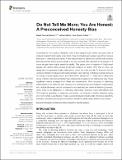Do Not Tell Me More; You Are Honest: A Preconceived Honesty Bias
Author(s)
Pascual-Ezama, David; Muñoz, Adrián; Prelec, Drazen
DownloadPublished version (242.3Kb)
Publisher with Creative Commons License
Publisher with Creative Commons License
Creative Commons Attribution
Terms of use
Metadata
Show full item recordAbstract
<jats:p>According to the previous literature, only a few papers found better accuracy than a chance to detect dishonesty, even when more information and verbal cues (VCs) improve precision in detecting dishonesty. A new classification of dishonesty profiles has recently been published, allowing us to study if this low success rate happens for all people or if some people have higher predictive ability. This paper aims to examine if (dis)honest people can detect better/worse (un)ethical behavior of others. With this in mind, we designed one experiment using videos from one of the most popular TV shows in the UK where contestants make a (dis)honesty decision upon gaining or sharing a certain amount of money. Our participants from an online MTurk sample (<jats:italic>N</jats:italic> = 1,582) had to determine under different conditions whether the contestants would act in an (dis)honest way. Three significant results emerged from these two experiments. First, accuracy in detecting (dis)honesty is not different than chance, but submaximizers (compared to maximizers) and radical dishonest people (compare to non-radicals) are better at detecting honesty, while there is no difference in detecting dishonesty. Second, more information and VCs improve precision in detecting dishonesty, but honesty is better detected using only non-verbal cues (NVCs). Finally, a preconceived honesty bias improves specificity (honesty detection accuracy) and worsens sensitivity (dishonesty detection accuracy).</jats:p>
Date issued
2021Department
Sloan School of Management; Massachusetts Institute of Technology. Department of Economics; Massachusetts Institute of Technology. Department of Brain and Cognitive SciencesJournal
Frontiers in Psychology
Publisher
Frontiers Media SA
Citation
Pascual-Ezama, David, Muñoz, Adrián and Prelec, Drazen. 2021. "Do Not Tell Me More; You Are Honest: A Preconceived Honesty Bias." Frontiers in Psychology, 12.
Version: Final published version